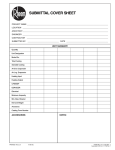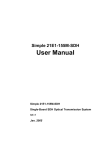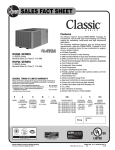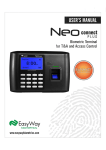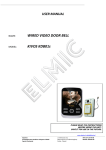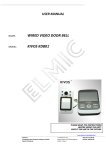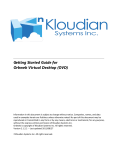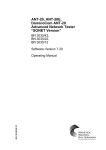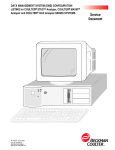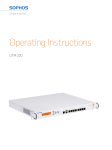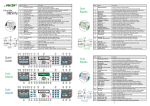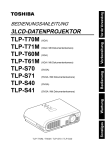Download 622X 622M cross-connected SDH Optical Transmission System
Transcript
622X 622M cross-connected SDH Optical Transmission System User’s Manual V1.11 Jun.2008 RSM-622X User’s Manual V1.11 Page 2 Revision History REVISION DATE DESCRIPTION V1.00 2005-11-25 Creation of File V1.01 2005-12-26 V1.10 2007-12-10 Modify the E1 cable order of serial management and auxiliary user channel. V1.11 2008-6-20 Modify the page description Modification of Figure of Equipment Panel Addition of Figures of Functional Blocks Table of Contents 1. Introduction ............................................................................................................. 6 1.1 Overview.................................................................................................................. 6 1.2 Product Features ..................................................................................................... 6 1.3 Compliant Technical Specifications and Standards ................................................. 7 2. Front Panel ............................................................................................................. 7 2.1 Front Panel Introduction .......................................................................................... 7 2.2 Serial NM and User Channel(RS232) .............................................................. 9 2.3 Ethernet NM Interface ............................................................................................. 9 3. Rear Panel ............................................................................................................. 9 3.1 Rear Panel Introduction ........................................................................................... 9 3.2 Power Supply Interface ........................................................................................... 9 3.3 NE Address............................................................................................................ 10 3.4 STM-4 Optical Interface ......................................................................................... 10 4. Function Structure ................................................................................................ 10 4.1. STM-4/1 Optical Interface Unit ............................................................................. 11 4.2. DXC (Data Cross Connection) Unit ...................................................................... 11 4. 3.SOT (Segment Overhead Terminal) Segment Overhead Terminal Unit................ 11 4.4 SET (SDH Equipment Timing) Equipment Timing ............................................... 12 4.5. NMU (Network Management Unit) Network Management Unit .......................... 12 5. Networking Application ......................................................................................... 12 5.1 Direct Upgrade of Existing STM-1 Network to STM-4 Network ........................... 12 5.2 Realization of E1 Tributaries Access into STM-4 Loop .......................................... 13 6. Equipment Grounding........................................................................................... 13 7. Installation of NM System ..................................................................................... 14 8. MAC address ........................................................................................................ 14 9. Technical Parameters ........................................................................................... 15 10. Physical Dimension and Environmental Requirements..................................... 15 Appendix 622X device fittings table ........................................................................ 16 RSM-622X User’s Manual V1.11 Page 3 Table Index Table 2-1-1 Front panel ports and mask switch............................................................................................. 8 Table 2-1-2 Front Panel indicators.............................................................................................................. 8 Table 2-1-3 Urgent Alarm and delayed Alarm ............................................................................................. 8 Table 2-2-1 Cable order of Serial network management and user channel .................................................. 9 Table 9-3 Serial NM Interface (RS232) ....................................................................................................... 15 Table 9-4 Ethernet NM Interface (NMU) ...................................................................................................... 15 Table10-1 Physical Dimension .................................................................................................................... 15 Table10-2 Environmental Requirements ..................................................................................................... 15 Figure Index Fig.2-1-1 Front panel of 622X ....................................................................................................................... 7 Fig 3-1-1 Rear Panel of 622X ..................................................................................................................... 9 Fig 3-3-1 Setting of NE Address ............................................................................................................... 10 Fig 4-1 RSM-622X Functional Block ........................................................................................................... 10 Figure 4-2 Default Configuration of Cross Connection................................................................................ 11 Figure 4-3 User Channel Forward Enabling Configuration ......................................................................... 12 Fig 5-1 Networking Application 1................................................................................................................. 13 Fig 5-2 Networking Application 2................................................................................................................. 13 Fig 6-1 Equipment External Grounding ....................................................................................................... 14 Fig 7-1 EasySDHTM NM System Main Interface ....................................................................................... 14 RSM-622X User’s Manual V1.11 Page 4 Abbreviations ADM Add-Drop Multiplexer AIS Alarm Indication Signal ALS Automatic Laser Shutdown APS Automatic Protection Switching AU Administrative Unit AUG Administrative Unit Group BER Bit Error Ratio BLSR Bidirectional Line Switched Ring SES Severely Error Seconds DCC Data Communications Channel DEG Degraded DXC Digital Cross Connect ES Error Second ID Identifier LC Link Connection LOF Loss Of Frame LOM Loss Of Multi-frame LOP Loss Of Pointer LOS Loss of Signal LP Lower order Path LTI Loss of all Incoming Timing references MCF Message Communications Function MS Multiplex Section MSOH Multiplex Section Overhead NDF New Data Flag NE Network Element NNI Network Node Interface NU National Use OFS Out-of-Frame Second OOF Out Of Frame OW Order Wire PDH Pre-synchronous Digital Hierarchy PLM Payload Mismatch PPI PDH Physical Interface PJE Pointer Justification Event POH Path Overhead PTR Pointer RDI Remote Defect Indication RSM-622X User’s Manual V1.11 REI Remote Error Indication RS Regenerator Section RSOH Regenerator Section Overhead SD Signal Degrade SDH Synchronous Digital Hierarchy SEC SDH Equipment Clock SES Severely Error Second SETS Synchronous Equipment Timing Source SPI SDH Physical Interface SNC SubNetwork Connection SOH Section Overhead SSM Synchronization Status Message STM Synchronous Transport Module TIM Trace Identifier Mismatch TMN Telecommunications Management Network TS Time Slot TU Tributary Unit TUG Tributary Unit Group ULSR Unidirectional Line Switched Ring UNEQ Unequipped UNI User Network Interface USR User channels VC Virtual Container Page 5 RSM-622X User’s Manual V1.11 Page 6 1. Introduction 1.1 Overview RSM-622X (STM-4) optical synchronous transmission system is one of the Raycom’s important members of transmission equipment , which comply with the Synchronous Digital Hierarchy (SDH) defined in ITU-T Recommendation G.707. It features high degree of integration, exquisite conformation, flexible networking, strong network adaptability, and other advantages. It is also comply with requirements of vibration, radiation, as well as electromagnetic compatibility, and other multiple international specifications. RSM-622X provides two 622.080Mb/s optical interfaces called E and F, and four 155.520155.520Mb/s optical interfaces of A, B, C, D. It also provides Network Elements (NE) timing function of ITU-T G.813 standard, 14×14 VC4 fully cross connection and channel protecting function with cross granularity as VC4, VC3 and VC12. RSM-622X can either work together with RSM-155 series SDH equipments, as Add-Drop Multiplexer (ADM) , as a Terminal Multiplexer (TM) or as a mini local cross-connect for applications in linear links, rings, and meshed networks. RSM-622X can also serve as Digital cross connecting equipment when working with SDH device other manufacturers, and can achieve a smooth upgrade from STM-1 to STM-4, while producing no impact on the existing NM system. The NE management of RSM-622X system is based on a unified Network Management System – EasySDH. EasySDH is designed in accordance with ITU-T related recommendations, to achieve management on network resources, equipment configuration, alarm, performance, and security. It is also able to support the unified management of subnetworks, with multiple optical paths which are not mutually connected, to support remote network monitoring and control by Internet. 1.2 Product Features ◆ Single board, with 1U height ◆ Four STM-1 optical interfaces work independently or be set as 1+1 ring protection ◆ Two STM-4 optical interfaces work independently or be set as 1+1 optical ports protection ◆ Standard SEC (SDH Element Clock) recommend by ITU-T G.813, synchronization timing interface, SSM function and automatic switching of multiple timing reference ◆ Supports clock modes of tracing (locked), free run and holdover ◆ Non-blocked cross connection among six optical interfaces, the granularity of which are VC4, VC3 and VC12 ◆ Point-to-point, chain and ring topologies. ◆ Provides D1~D3 bytes of the ECC channel and TCP/IP as the network management protocol RSM-622X User’s Manual V1.11 Page 7 ◆ Provides F (Ethernet) and f (RS232) NMS interface, network management platform EasySDH. Realizes the resources, configuration, alarm, performance and security functions proposed by ITU-T standards ◆ Embedded network management software supports remote upgrading ◆ Optional optical module of long/short distance and ALS/Non-ALS function 1.3 Compliant Technical Specifications and Standards G.703 G.707 G. 781 G. 782 G. 783 G.784 G.803 G. 811 G. 813 G.823 G. 825 G. 826 G. 841 G. 957 G. 958 Physical/Electrical Properties of Digital Interfaces for Digital Transmission Terminal Equipment Network Node Interface of Synchronous Digital Hierarchy (SDH) Composition of Related Recommendations for SDH Multiplexing Equipment Related Types and General Properties of SDH Multiplexing Equipment Function Block Properties of SDH Multiplexing Equipment SDH Management SDH’s Transmission Network Structure Timing Requirements of Clock Output Terminal and Network Nodes Applicable to international digital link PHD Operation SDH Equipment Secondary Clock (SEC) Properties Jitter and Drift Control in Digital Network Based on 2048Kb/s System Jitter and Drift Control in Digital Network based on SDH Bit Error Properties and Targets of Primary Group and above International Fixed Rate Channels Types and Properties for Protection of SDH Networks in Different Structures SDH-Related Optical Interfaces of Equipment and Systems SDH Based Fiber Cable Digital Line Systems The Ministry of Information Industry “Optical Synchronous Transmission Network Technical System” Governmental Standard “SDH Fiber Cable Line System Network Access Requirements” 2. Front Panel 2.1 Front Panel Introduction The front panel is arranged with STM-1 optical interface, equipment operating and alarming LED, management interface and mask switch of alarm voice, etc. A OUT IN B OUT IN C OUT IN D OUT IN RS232 NMU RUN A B 5 6 7 C D E 8 Fig.2-1-1 Front panel of 622X F XE1 ETH ALAR M MUTE PHONE RSM-622X User’s Manual V1.11 Page 8 Table 2-1-1 Front panel ports and mask switch Name Description OUT IN Remark STM-1 optical output STM-1 optical input Serial NM and user transparent channel interface RS232 NMU Network management interface RJ45 port, serial NM and user transparent channel cable. Note: the cable is not in the packing list, it should be made by customer RJ45 port, use CAT-5 cross or straight cable. Note: the cable is not in the packing list, it should be made by customer. ALARM(the button is up):Enable the alarm voice Mask switch MUTE ( the button is push down):mask the alarm voice Table 2-1-2 Front Panel indicators Name Description RUN Run indicator, Green. Lighting means work well. Optical Interface Status Indication. Off indicates that this optical interface does not exist, green indicates normal operation, red means urgent alarm, and yellow stands for delayed alarm. Status Indication of extended service card. Not use temporarily. A/B/C/D/E/F XE1 Table 2-1-3 Urgent Alarm and delayed Alarm Name Description Equipment Urgent Alarm The default urgent alarm including: NOP (NO Power) LOF (Loss of Frame) MS_EXC ( Multiplex Section Excessive errors) AU_LOP (Administrative Unit Loss of Pointer) HP_PLM (Higher order Path Payload Mismatch) HP_TIM (Higher order Path Trace Identifier Mismatch) HP_EXC ( Higher order Path Excessive errors)) TU_LOP (Tributary Unit Loss of Pointer) Equipment Delayed Alarm The default delayed alarm including: MS_AIS (Multiplex Section Alarm Indication Signal) MS_RDI (Multiplex Section Remote Defect Indication ) MS_DEG ( Multiplex Section Degraded) HP_AIS (Higher order Path Alarm Indication Signal) HP_RDI (Higher order Path Remote Defect Indication) TU_AIS ( Tributary Unit Alarm Indication Signal) LTI (Loss of all main Incoming Timing references) RSM-622X User’s Manual V1.11 2.2 Page 9 Serial NM and User Channel(RS232) 622X provide RJ-45 interface, used for serial network management and user channel. Table 2-2-1 Cable order of Serial network management and user channel Pin PIN1 PIN2 PIN3 PIN4 PIN5 PIN6 PIN7 PIN8 Definitio n RSNM-OUT Remark Serial NM Voltage) Channel output (RS232 input (RS232 RSNM-IN Serial NM Voltage) GND Data-IN Data-OUT Null Null Null Signal GND Serial data input(RS232 Voltage) Serial data output(RS232 Voltage) Channel 2.3 Ethernet NM Interface Besides the RS232 Serial NM Interface,RSM-622X also provides an Ethernet NM interface called NMU, Either standard cross network cable or through one can be used in the connection between the interface and the NMS The cable order will not be described here The customer can change the mac and ip address of the equipment to fulfill the application, refer to the “EasySDH user manual” for more information. 3. Rear Panel 3.1 Rear Panel Introduction The following is a schematic diagram for rear panel of RSM-622X equipment, with power interface, address switch, and STM-4 optical interface, etc. ~220V PGND GND -48V ADDRSS MSB LSB POWER E OUT IN F OUT IN 1 0 1 2 3 4 5 6 7 8 ×10 Fig 3-1-1 ×1 Rear Panel of 622X 3.2 Power Supply Interface The device provide two power supply interface, AC220V and DC-48V, the default is DC-48V. The AC 220V power interface should be declare in the order. Note: AC220V and DC-48V cannot be used at the same time! RSM--622X User’s Manual M V1.11 Page 10 0 3.3 NE N Addres ss The range of T o the device e address is from 00 to 98, 9 which is set by the a address swittch on the re ear panel. The T device address a is unique mark used for ne etwork eleme ent management, Differrent device in a netw work can no ot be set to t the same address, otherwise, the mana agement sysstem can’t achieve a the successful s access a to it. A described in the follo As owing figure e, the left 4-p position of the switch iss for the tens s digit of the e address called MSB, while the rig ght 4-positio on is for the unit digit ca alled LSB, both of which h are in 8421 BCD code e mode. T Take the exa ample of the e figure, the address is “11” “ Fig 3-3-1 Setting off NE Addresss 3.4 STM-4 S Optical Interfface The two STM-4 optical interfaces of T o RSM-622X X locates on n right side o of the back panel with SC S type, and customer shall declarre during ord dering if FC type interfacce is needed d. 4. Function F n Structu ure A ST TM-1 B STM M-1 STM M-4 C D STM-1 1 STM-1 ST TM-4 DXC E SETS S NMU F SOT Fig 4-1 RSM M-622X Functional Block system inccludes two STM-4 optical interface units, fou R RSM-622X ur STM-1 optical o RSM-622X User’s Manual V1.11 Page 11 interface units, functional modules of data cross connection(DXC), overhead transaction (SOT), equipment timing source(SETS), management unit(NMU) and etc. 4.1. STM-4/1 Optical Interface Unit It fulfills process of STM-1/STM-4 optical signal in SDH system, including the section overhead (SOH) and high-order channel overhead process, pointer process, TU pointer alignment (TUPP) and so on. It can achieve automatic laser shutdown (ALS) function or super-long distance transmission by changing particular optical module, which physical interface can be FC or SC. 4.2. DXC (Data Cross Connection) Unit It is able to achieve cross-through, broadcast, add/drop and loop cross connection. Any cross connection mode can be achieved for service entering into the lines and the tributaries inside the equipment. For the convenience of application, the four VC4s of the E optical interfaces (STM-4) are defined as E_1, E_2, E_3, and E_4 in turn, and the four VC4s of F optical interface (STM-4) as F_1, F_2, F_3, and F_4, respectively. The equipment default configuration is ,E and F optical interfaces are in mutual protection,all service channels are TU-12, four STM-1 optical interfaces of A to D are independent for adding and dropping service, respectively cross connect with E_1 (F_1), E_2 (F_2), E_3 (F_3), and E_4 (F_4), as indicated in the following figure. Figure 4-2 Default Configuration of Cross Connection 4. 3.SOT (Segment Overhead Terminal) Segment Overhead Terminal Unit It is to achieve termination and insertion for the part of segment overhead. One RS-232 bus channel is provided, using F1 of overhead for transmission. The option for service initiating site “F1 Transmission Enable” must be set as Disable in application, and that for other sites are to be set as Enable. And ensure that there is only one site which send data to the bus at any moment. RSM--622X User’s Manual M V1.11 Page 12 2 Figure e 4-3 User Channel C Forw ward Enablin ng Configura ation DCC channel c , which w occu upy D1~D3,, used for communica ation of ne etwork e elements. EOW in nterface is not n provided d by the equ uipment; how wever, when n connecting g with o other SDH equipment of our com mpany, E1 overhead byte b used ffor EOW ca an be automaticallly, to ensu c configured ure that orriginal telep phone syste em can op perate n normally. nally, to havve no impact on the NM N system of o other ma anufacture whose w Addition e equipment c connected w RSM-62 with 22X, standb by overhead of E1’/F1’/D1’~D3’ use ed for N are provvided .The “route NM “ way settings” s is set to be “n non standard d” through NM N to r realize the usage u of stan ndby overhe ead. 4.4 SET (SDH Equipm ment Timin ng) Equipm ment Timin ng It is to provide interface for external tim ming signalss and the timing sourrce of equipment, to e t give a tim ming referencce to differen nt functional modules off SDH equipment. It provid des a selecttive clock fu unction of diffferent priority, using S1 1 byte, as well w as c complete fu unction for synchronous s s status me essages (SSM), to ensure the re eliable o operation off clock. It can n track A, B, C, D, E, an nd F six line e timing sourrces (LTS), and a is a able to achie eve automattic switch ba ased on qua ality levels off timing sourrce. 4.5. NMU (Ne etwork Ma anagemen nt Unit) Ne etwork Ma anagementt Unit It fulfill the manage ement of the e equipmentt and comm munications b between ne etwork e elements, an nd provide an a Ethernet interface an nd an RS-23 32 interface ffor access. 5. Network N king Appllication 5.1 Direct Up pgrade of Existing STM-1 S Network to STM-4 S Nettwork Establishing E g on the exisstent STM-1 equipment by STM-1 optical o interfface, RSM-6 622 X is ab ble to upgrade the orriginal STM--1 network to STM-4 network, sso as to en nlarge transsmission cap pacity. I the origina If al STM-1 is an equipme ent of anothe er manufactturer, overhe ead mode can be set th hrough NM software, s to retain the NM N system of o the origina al equipmen nt. RSM-622X User’s Manual V1.11 Page 13 STM-1 NE2 622X 622X STM-1 NE3 STM-4 Ring STM-1 NE1 622X STM-1 NE2 STM-1 NE3 STM-1 Ring STM-1 NE1 Fig 5-1 Networking Application 1 5.2 Realization of E1 Tributaries Access into STM-4 Loop The four STM-1 optical interfaces provided by RSM-622X, can serve as up and down optical tributary services, in cooperation with RSM-155C/CP, and can provide up to 252 E1. 622X STM-4 Ring 622X 622X 4×STM-1 STM-1 NE1 252×E1 Fig 5-2 Networking Application 2 6. Equipment Grounding As a small-sized equipment, RSM 622X ground is divided into two types-working ground and protection ground. When equipment runs normally, it is necessary for GND and PGND to be connected with the earth. The PGND resistance shall be not more than 4Ω and RSM-622X User’s Manual V1.11 Page 14 2 the minimum cross section of GND wire should not be less than 6mm , so as to provide essential conditions for safe and stable operation. NOTE: The PGND of the equipment has been connected to the box defaultly. Please refer to the following figure to complete the connection Fig 6-1 Equipment External Grounding 7. Installation of NM System “Easy SDHTM NM System User Manual” must be referred to before the installation of Easy SDHTM NM system, and the equipment IP address shall be set as the advance customer IP address assignment. Login in the software, and the default account is Administrator, with the password is null. Please enter into user management for account adding or deleting and password modifying if necessary. Pay attention that the default IP address of the equipment is 192.168.0.157. The address of NM PC shall be set and kept at the identical IP segment. Fig 7-1 EasySDHTM NM System Main Interface 8. MAC address The device is assigned by a unique MAC Address in the world, which was stunk on the RSM-622X User’s Manual V1.11 Page 15 side face of the device. 9. Technical Parameters Table 9-1 STM-1 Optical Interface Technical Indices 1310nm Working Wavelength Rate Standard Type of Medium Transmission Distance Receiving Sensitivity 155.520Mb/s± 4.6ppm ITU-T G.957/G.958 ITU-T G.652/G.653, Single-mode 40Km (Optional for long-distance transmission, and user must specify during ordering.) prior to –36dB FC (optional for SC interface ,and user must specify Adapter during ordering) Table 9-2 STM-4 Optical Interface Technical Indices 1310nm Wavelength Rate Standard Type of Medium Transmission Distance Receiving Sensitivity 622.080Mb/s±4.6ppm. ITU-T G.957/G.958. ITU-T G.652/G.653, Single-mode 40Km (optional for long-distance transmission, and user must specify during ordering) prior to –28dB SC, optional for FC interface, and user must specify Interface during ordering. Table 9-3 Serial NM Interface (RS232) Rate Interface 19200b/s RJ45 Table 9-4 Ethernet NM Interface (NMU) Mode Interface 10/100Mb/s, Half/Full duplex autonegotiation RJ45 10. Physical Dimension and Environmental Requirements Table10-1 Physical Dimension Size 483mm (L) x 290mm (W) x 44mm (H) Weight 4.0kg Table10-2 Environmental Requirements Project parameters RSM-622X User’s Manual V1.11 Page 16 Power Supply Power consumption Operating temperature Relative Humidity Air Pressure Environmental Air DC:-36V~-72V;AC:176V~275V 35W±10% 0~45°C ≤90%(Non-condensing) 70~106Kpa be away from corrosive, solvent gases, dust, and not adjacent to strong magnetic field. Grounding requirement Resistance : ≤4Ω Appendix 622X device fittings table No Name Specification quantity 1 Fuse 3A 1 RJ-45 3 2 Modular plug Remarks Used in Double power 3 200V power cable 1 supply
















